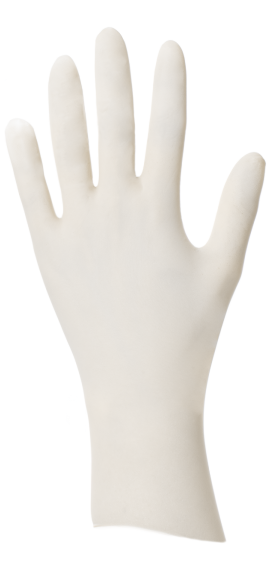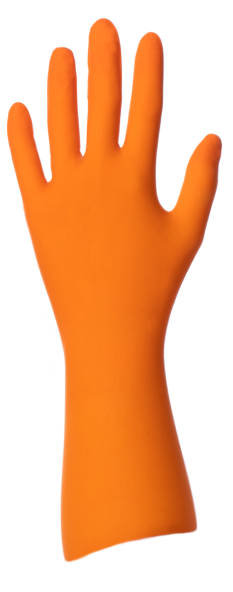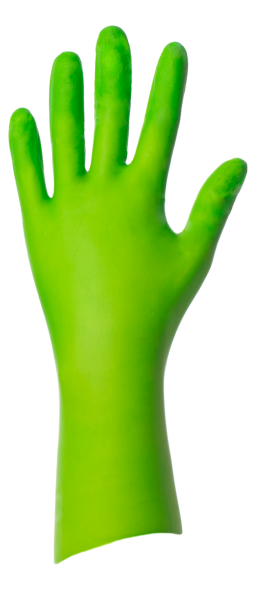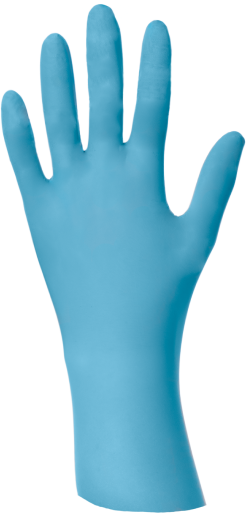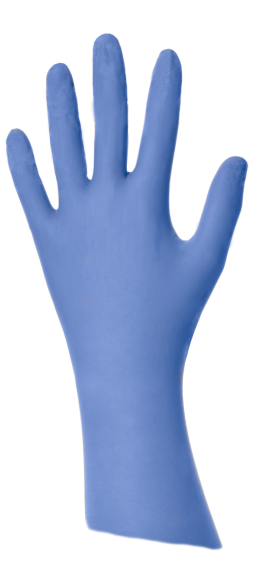WHICH GLOVES TO CONTROL THE CONTAMINATION RISK?
Controlling the risks of contamination in a cleanroom environment means doing all the necessary to ensure the protection of the process and the product against any particulate, microbiological or chemical contamination, without neglecting the protection of personnel.
The impacts of contamination can indeed be disastrous both in terms of health safety (risks to human and animal health up to death) and economic (shutdown of produTction lines, destruction of entire batches).
However, regulatory constraints on quality, reliability and safety are increasingly strong and complicate industrial processes. It is even more important to know and understand the cleanroom control of contamination risks issues and in particular the specificity of nitrile and latex cleanroom gloves in the management of this risk.
What are the risks of contamination in a cleanroom?
When referring to contamination this usually means that the execution of a process is affected or even prevented (care, production, assembly) or that the environment is degraded (pollution).
A "contaminant" is a foreign element that can usually be a particle, a microorganism, or a chemical.
Particulate contamination
This is contamination due to a too high concentration of inert particles (dust, fibres, etc.). Particles origin may be telluric or due to the use/wear of equipment (furniture, production ...), clothing materials, fragments of human skin ...
Particulate contamination can stop production lines or affect the quality and reliability of manufactured or assembled products.
The industries mainly concerned by the risks associated with particulate contamination are:
- Micro and nanoelectronics
- Space and aeronautics
- Optics
- Micromechanics
- Automotive
There is a particular case related to ionic contamination resulting from the concentration of organic or inorganic contaminants which is particularly feared in the semiconductor industry. Indeed, ionic contamination can lead to corrosion (embrittlement of the metal parts of the component), loss of insulation properties (which can lead to short circuits) or electrochemical migration (potential cause of short circuits also).
ISO 14644 (Cleanrooms and associated controlled environments — Part 1: Classification of air cleanliness by particle concentration) specifies the classification of cleanroom air cleanliness. It concerns the determination of the concentration of suspended in the air particles size range from 0.1 μm to 5 μm. It should be noted that particles, depending on their size, can carry other contaminants such as microorganisms.
Microbiological contamination or biocontamination
Microorganisms are very small viable organisms, present in large numbers in the environment and reproducing at a very rapid rate. Due to their low mass, they can be easily carried by inert particles.
Microorganisms include bacteria, microscopic fungi and algae, viruses, etc.
A biocontamination can have far reaching consequences in a number of activities. In the medical sector, human health may be at stake in the event of contamination of injectable products or implants of medical devices. This can also apply to the food industry in the case of pathogens in produced food.
The industries mainly concerned by the risks associated with microbiological contamination are:
- Pharmaceutical
- Cosmetic
- Medical devices
- Biotechnology
- Food
- Veterinary laboratories
There is a specific concern regarding the contamination of sterile injectable products or implants by non-viable microorganisms such as endotoxins in the pharmaceutical and medical device industries. Endotoxins, which are residues of bacterial membranes, can be more or less numerous depending on the level of bioburden before sterilizing the products. The pyrogen nature of endotoxins makes them a formidable foe for weakened patients (immunocompromised, very young or very old for example).
Chemical or molecular contamination
Chemical or molecular contamination is the result of a contamination by chemical elements whose concentration levels can go as far as molecular contamination (fine particles, solid or liquid aerosols, gases). This can therefore be an airborne (gas or vapour) or surface (absorption of a product) contamination.
It may also be cross-contamination resulting from the contamination of one product by another during simultaneous or successive productions.
The consequences in the hospital sector and the pharmaceutical industry can be significant.
The industries mainly concerned by the risks associated with chemical contamination are:
- Agri-food via fertilizers, pesticides, veterinary drugs etc ...
- Pharmaceutical
- Microelectronics
ESD as an aggravating factor of contamination
ESD (Electrostatic discharge) as such is not a contaminant but can be considered an aggravating factor of contamination.
Knowing the consequences of electrostatic discharges on electronic devices or in explosive environments, the need to take this factor into account is obvious.
The industries mainly concerned by the risks associated with static electricity are:
- Electronic
- Semiconductor
- Nanotechnologies
- Pharmaceutical
Do not hesitate to read our article dedicated more specifically to ESD single-use gloves.
Know and master the sources of contamination in cleanrooms
As the contamination is at the particulate level, the risk is necessarily invisible. It is therefore essential to know the potential sources of contamination and how to analyse them.
Suitable provision shall be made to control the risk of contamination in accordance with the requirements and constraints of the production process.
First, you should know that in a cleanroom the main sources of contamination are:
- People: It is believed that 75% of the sources of contamination in a cleanroom are human induced. (Note that man is both a source of particulate and microbiological contamination (hair, skin, secretions) but also a transfer vector of the contamination by his gestures and movements).
- Environment.
- Equipment.
- Fluids used during the process.
- Raw materials.
- Etc …
Thus, to control contamination, of any nature whatsoever, and ensure the appropriate level of cleanliness for the process:
- 01 The cleanroom enclosure must be delimited and composed of an envelope which have specially been designed for the process (Tight envelope, SAS for personnel, raw materials, equipment, products, waste, etc.).
- 02 Air flows and treatments must be managed precisely (type of flow, filtration, pressure or depression, temperature, hygrometry, etc.).
- 03 Personnel, raw materials and equipment’s entry and exit procedures must be setting up.
Controlling the risks of human contamination in a cleanroom
Knowing that human being is the main origin of contamination, and knowing the consequences of contamination on processes, it seems essential to control the human factor in risk management.
Control the risks of contamination by personnel demands strict compliance with basic hygiene rules, in particular the hands. But risk management also involves wearing appropriate garments, dressing procedures training, entry/exit from the cleanroom and behaviours to adopt indoors (in terms of movements) without forgetting regular monitoring of microbial contamination.
Garments:
Garments worn in the cleanroom by the staff as well as the accessories (PPE such as single-use gloves) must meet the requirements of the process while not affecting the cleanliness requirements. It is therefore important to choose cleanroom garments and accessories, including cleanroom designed single-use nitrile or latex gloves.
Personnel cleanroom garment must be, according to the classification of the cleanroom:
- Sterile or sterilizable in some cases.
- Whole covering (no part of the body should be uncovered, including the forearms).
- Made of no particles releasing materials.
- Mechanically resistant.
- Resistant to chemicals handled.
- Either not or low generation of static electricity generation if necessary.
Training:
Staff training is also important regarding dressing procedures before entering the cleanroom as well as how to move and how to move objects in a cleanroom.
In aseptic areas, garment dressing should comply with an even stricter procedure to avoid contamination of the outfit before entering a clean room.
Operators should also receive donning and doffing sterile nitrile or latex single-use gloves training to ensure that they do not get dirty or soil the gloves before or after use.
Some activities also require wearing 2 pairs of gloves (when the risks are high for the staff or when the process requires it). When double-gloving with sterile gloves, a procedure for donning the 2 pairs of sterile cleanroom gloves must be followed strictly to limit the risk of contamination.
Monitoring:
Regular monitoring to ensure that there is no contamination is essential.
Regarding the pharmaceutical industry, and more particularly sterile medicines manufacturing, the new Annex 1 of the GMP introduces more principles on the Quality Risk Management (QRM).
Various sampling to ensure environmental microbiological monitoring must therefore be carried out regularly in areas with aseptic controlled atmospheres.
Single-use gloves are also concerned with samples. Periodic sampling as well as at each production are thus carried out on the gloves. These sampling check consist in applying of all gloved fingers on a contact agar, in a 90 mm Petri dish, before incubation and enumeration of Colony Forming Units (CFU).
The new GMP Annex 1 regarding the rules governing sterile medicinal products manufacturing has set a maximum level of microbiological contamination depending on the grade of the cleanroom manufacturing area:
|
|
CFU/m3 |
(Diameter 90 mm) CFU/4 hours |
(Diameter 55 mm) CFU/Plate |
|---|---|---|---|
|
|
|
||
|
|
|
|
|
|
|
|
|
|
|
|
|
|
|
How to select the appropriate nitrile or latex cleanroom glove?
As regards cleanroom gloves specific case, the selection criteria must consider the requirements of the process and the level of cleanliness sought. There are a number of technical, physical, protective and cleanliness characteristics that you need to know when selecting the cleanroom glove adapted for the process:
Protection of personnel and process:
As a Personal Protective Equipment, nitrile or latex cleanroom gloves must first meet Regulation (EU) 2016/425 requirements on PPE.
When protection against microbiological and chemical risks is an issue, it is necessary to know the Acceptable Quality Level (AQL). The AQL is determined by a water or air penetration test allowing the detection of micro-holes. The lower the AQL, the higher the protection.
Sometimes, the process requires wearing sterile nitrile or latex cleanroom gloves. It is therefore necessary to get the manufacturer's guarantee that the cleanroom gloves have undergone sterilization to achieve a sterility assurance level (SAL) of 10-6 in accordance with ISO 11137-2:2015.
It may also be essential to ensure that cleanroom gloves have a low endotoxins content < 20 EU/pair of gloves according to EN 455-3:2015.Read our article on controlling endotoxin contamination on sterile cleanroom gloves.
Gloves should be long enough to cover the whole cleanroom coverall cuff not to leave obvious skin. Sometimes it may also be essential that gloves' cuff go up high enough along the coverall sleeve to permit regular disinfection. Indeed, when working in the most critical areas (Grade A or B) and to comply with EU GMP, it is now recommended to regularly sample the sleeve (Article 9.32 of Annex 1 on Manufacture of Sterile Drugs) as well as the hand to demonstrate that there are 0 CFUs – Colony Forming Unit. Longer sterile gloves (400 to 600 mm) allow to spray the entire arm area with isopropyl alcohol (IPA), thus minimizing the risk of deviations and therefore lost production time.
Cleanroom gloves cleanliness:
Obviously, as particulate contamination needed to be controlled, cleanroom gloves must be non-powdered.
The gloves particle level must be adapted to the cleanliness requirements of the process Read our article to learn more about the particulate cleanliness performance of cleanroom gloves.
Some industries will require to ensure the type and level of extractables potentially present in the gloves.
The cleanroom gloves packaging shall comply with cleanliness requirements. All cardboard packaging should be avoided, and PE packaging should be preferred. For the most critical environments (e.g., A/B grade cleanrooms in the pharmaceutical industry) gloves that are packed in a multiple-layer sealing PE packing will allow a gradual and secure unpacking through the SASs to access to the different grades of the cleanroom.
To help users to select nitrile or latex cleanroom gloves that meet the requirements of their critical environments, SHIELD Scientific has an online glove selection guide.
Contamination control requires a good knowledge of the different contamination factors to adapt your equipment and process. Single-use nitrile or latex gloves, whether sterile or not, must be selected with the utmost care to meet safety and quality issues.
SHIELD Scientific specializes in cleanroom single-use gloves suitable for manufacturing processes in critical environments. Certificates of Conformity (CoC) and Irradiation (CoI - For sterile gloves) are available upon request for all SHIELD Scientific cleanroom gloves.
For further information, advice, or samples, do not hesitate to contact us.

